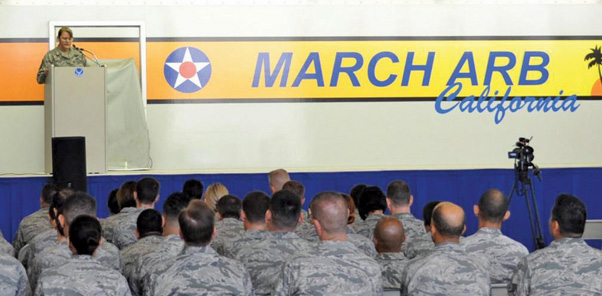Airmen were introduced to the new Enlisted Evaluation System at one of two briefings given here, Sunday, Oct. 4. The new system, which became effective Oct. 1, is designed to more easily recognize outstanding Airman. Under the old Enlisted Performance Report system, scores were easily inflated, making it more difficult to distinguish between exceptional and average Airmen.
“The evaluation system for the Air Force has significantly changed over the last year,” said Chief Master Sgt. Michelle Thomas, A-1 superintendent, Air Force Reserve Command. “There are reservist-specific issues that we have to address when it comes to evaluations. I wanted to make sure the reserve-specific bases got the information, as well as everybody else,” Thomas said. “We have three teams that are going to March, Niagara, Pittsburgh, Grissom, and all of the bases that are Reserve only. We’ll be back here for the B UTA.”
Each hour-long briefing started with Power Point slides to show everyone what the new form looks like and to familiarize Airmen with the new process and included question and answer sessions.
The new EES gives the ratee an opportunity to self-assess on personal responsibility and accountability. It gives the rater the responsibility to assess his or her subordinate on primary duty performance, followership and leadership capabilities, and the whole Airman concept based on a cumulative performance record. There is also the ability to identify promotion potential based on that record.
In addition, there is a mandatory, midterm Airman Comprehensive Assessment (ACA) that includes supporting documentation. This ACA has a direct correlation to the new Enlisted Performance Report forms.
Other changes include aligning closeout dates by rank for a fair and equitable evaluation of peer groups, and the elimination of Change of Reporting Official reports, 59-day extension requests and minimum days of supervision requirements.
“I wanted to make sure we explained to everyone why we actually made these changes,” said Thomas. “We want everyone to have a good comprehensive understanding of what we’ve done and why, and I think we accomplished that today.”
To learn more about the process, contact your unit first sergeant, superintendent or command chief.



